
- 阻害剤
- 研究分野別
- PI3K/Akt/mTOR
- Epigenetics
- Methylation
- Immunology & Inflammation
- Protein Tyrosine Kinase
- Angiogenesis
- Apoptosis
- Autophagy
- ER stress & UPR
- JAK/STAT
- MAPK
- Cytoskeletal Signaling
- Cell Cycle
- TGF-beta/Smad
- 化合物ライブラリー
- Popular Compound Libraries
- Customize Library
- Clinical and FDA-approved Related
- Bioactive Compound Libraries
- Inhibitor Related
- Natural Product Related
- Metabolism Related
- Cell Death Related
- By Signaling Pathway
- By Disease
- Anti-infection and Antiviral Related
- Neuronal and Immunology Related
- Fragment and Covalent Related
- FDA-approved Drug Library
- FDA-approved & Passed Phase I Drug Library
- Preclinical/Clinical Compound Library
- Bioactive Compound Library-I
- Bioactive Compound Library-II
- Kinase Inhibitor Library
- Express-Pick Library
- Natural Product Library
- Human Endogenous Metabolite Compound Library
- Alkaloid Compound LibraryNew
- Angiogenesis Related compound Library
- Anti-Aging Compound Library
- Anti-alzheimer Disease Compound Library
- Antibiotics compound Library
- Anti-cancer Compound Library
- Anti-cancer Compound Library-Ⅱ
- Anti-cancer Metabolism Compound Library
- Anti-Cardiovascular Disease Compound Library
- Anti-diabetic Compound Library
- Anti-infection Compound Library
- Antioxidant Compound Library
- Anti-parasitic Compound Library
- Antiviral Compound Library
- Apoptosis Compound Library
- Autophagy Compound Library
- Calcium Channel Blocker LibraryNew
- Cambridge Cancer Compound Library
- Carbohydrate Metabolism Compound LibraryNew
- Cell Cycle compound library
- CNS-Penetrant Compound Library
- Covalent Inhibitor Library
- Cytokine Inhibitor LibraryNew
- Cytoskeletal Signaling Pathway Compound Library
- DNA Damage/DNA Repair compound Library
- Drug-like Compound Library
- Endoplasmic Reticulum Stress Compound Library
- Epigenetics Compound Library
- Exosome Secretion Related Compound LibraryNew
- FDA-approved Anticancer Drug LibraryNew
- Ferroptosis Compound Library
- Flavonoid Compound Library
- Fragment Library
- Glutamine Metabolism Compound Library
- Glycolysis Compound Library
- GPCR Compound Library
- Gut Microbial Metabolite Library
- HIF-1 Signaling Pathway Compound Library
- Highly Selective Inhibitor Library
- Histone modification compound library
- HTS Library for Drug Discovery
- Human Hormone Related Compound LibraryNew
- Human Transcription Factor Compound LibraryNew
- Immunology/Inflammation Compound Library
- Inhibitor Library
- Ion Channel Ligand Library
- JAK/STAT compound library
- Lipid Metabolism Compound LibraryNew
- Macrocyclic Compound Library
- MAPK Inhibitor Library
- Medicine Food Homology Compound Library
- Metabolism Compound Library
- Methylation Compound Library
- Mouse Metabolite Compound LibraryNew
- Natural Organic Compound Library
- Neuronal Signaling Compound Library
- NF-κB Signaling Compound Library
- Nucleoside Analogue Library
- Obesity Compound Library
- Oxidative Stress Compound LibraryNew
- Phenotypic Screening Library
- PI3K/Akt Inhibitor Library
- Protease Inhibitor Library
- Protein-protein Interaction Inhibitor Library
- Pyroptosis Compound Library
- Small Molecule Immuno-Oncology Compound Library
- Mitochondria-Targeted Compound LibraryNew
- Stem Cell Differentiation Compound LibraryNew
- Stem Cell Signaling Compound Library
- Natural Phenol Compound LibraryNew
- Natural Terpenoid Compound LibraryNew
- TGF-beta/Smad compound library
- Traditional Chinese Medicine Library
- Tyrosine Kinase Inhibitor Library
- Ubiquitination Compound Library
-
Cherry Picking
You can personalize your library with chemicals from within Selleck's inventory. Build the right library for your research endeavors by choosing from compounds in all of our available libraries.
Please contact us at info@selleck.co.jp to customize your library.
You could select:
- 抗体
- 新製品
- お問い合わせ
COVID-19
COVID-19製品
- All (64)
- COVID-19阻害剤 (63)
- 新製品
| 製品コード | 製品名称 | 製品説明 | 文献中Selleckの製品使用例 | お客様のフィードバック |
|---|---|---|---|---|
| S2853 | Carfilzomib (PR-171) | Carfilzomib (PR-171) is an irreversible proteasome inhibitor with IC50 of <5 nM in ANBL-6 cells, displayed preferential in vitro inhibitory potency against the ChT-L activity in the β5 subunit, but little or no effect on the PGPH and T-L activities. Carfilzomib activates prosurvival autophagy and induces cell apoptosis. |
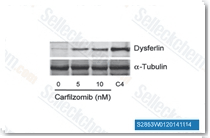
|
|
| S4157 | Chloroquine diphosphate | Chloroquine diphosphate is a 4-aminoquinoline anti-malarial and anti-rheumatoid agent, also acting as an ATM activator. Chloroquine is also an inhibitor of toll-like receptors (TLRs). |
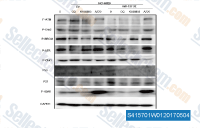
|
|
| S6999 | Chloroquine | Chloroquine is an antimalarial drug and autophagy/lysosome inhibitor. Chloroquine also suppresses Toll-like receptor-9 (TLR9) protein expression. Chloroquine is highly effective agianst SARS-CoV-2 (COVID-19) infection with EC50 of 1.13 μM in Vero E6 cells. Chloroquine has anti-HIV-1 activity. | ||
| S4430 | Hydroxychloroquine (HCQ) Sulfate | Hydroxychloroquine (HCQ) Sulfate is an antimalarial agent used for the treatment of systemic lupus erythematosus, rheumatoid arthritis and other autoimmune, inflammatory and dermatologic conditions. Also acts as an inhibitor of autophagy and toll-like receptor (TLR) 7/9. |
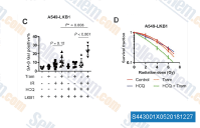
|
|
| S1322 | Dexamethasone | Dexamethasone is a potent synthetic member of the glucocorticoid class of steroid drugs, and an interleukin receptor modulator that has anti-inflammatory and immunosuppressant effects. Dexamethasone induces autophagy and mitophagy. Dexamethasone is tested in hospitalized patients with COVID-19 and is found to have benefits for critically ill patients. |
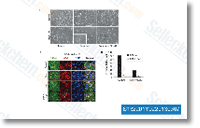
|
|
| S8932 | Remdesivir (GS-5734) | Remdesivir (GS-5734), a monophosphoramidate prodrug of an adenosine analog, is an investigational broad-spectrum antiviral agent with in vitro activity against multiple RNA viruses, including Ebola and CoV. | ||
| S3035 | Daunorubicin HCl | Daunorubicin HCl inhibits both DNA and RNA synthesis and inhibits DNA synthesis with Ki of 0.02 μM in a cell-free assay. Daunorubicin is a topoisomerase II inhibitor that induces apoptosis.Daunorubicin (RP 13057) HCl can be used to induce animal models of Kidney Disease. |
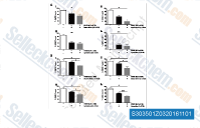
|
|
| S2851 | Baricitinib (LY3009104) | Baricitinib is a selective JAK1 and JAK2 inhibitor with IC50 of 5.9 nM and 5.7 nM in cell-free assays, ~70 and ~10-fold selective versus JAK3 and Tyk2, no inhibition to c-Met and Chk2. Baricitinib is found to reduce or interrupt the passage of the virus into target cells and is used in the treatment research for COVID-19. Phase 3. |
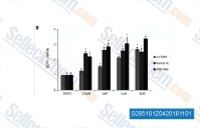
|
|
| S2485 | Mitoxantrone 2HCl | Mitoxantrone 2HCl is a dihydrochloride salt of Mitoxantrone. Mitoxantrone is an inhibitor of type II topoisomerase and protein kinase C (PKC) with IC50 of 8.5 μM for PKC. Mitoxantrone inhibits cell proliferative growth of MCF-7/wt cells with IC50 of 0.42 μM. Mitoxantrone also induces apoptosis. |
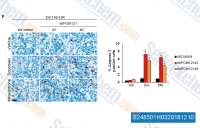
|
|
| S1380 | Lopinavir (ABT-378) | Lopinavir (ABT-378) is a potent HIV protease inhibitor with Ki of 1.3 pM in a cell-free assay. |
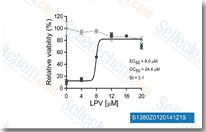
|
|
| S1538 | Telaprevir | Telaprevir is an HCV NS3-4A serine protease inhibitor with IC50 of 0.35 μM. |
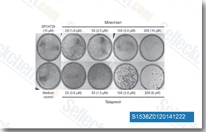
|
|
| S1185 | Ritonavir | Ritonavir is a Cytochrome P450 3A and Protease Inhibitor; Also inhibits Cytochrome P450 2D6, P-Glycoprotein and induces Cytochrome P450 2C19, Cytochrome P450 1A2, Cytochrome P450 2C9, Cytochrome P450 2B6 and UDP Glucuronosyltransferases. Ritonavir induces apoptosis. |
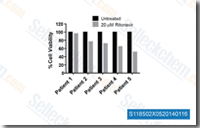
|
|
| S1680 | Disulfiram (Tetraethylthiuram disulfide) | Disulfiram is a specific inhibitor of aldehyde-dehydrogenase (ALDH) with IC50 of 0.15 μM and 1.45 μM for hALDH1 and hALDH2, respectively. Disulfiram is used for the treatment of chronic alcoholism by producing an acute sensitivity to alcohol. Disulfiram induces apoptosis. Disulfiram is also an inhibitor of pore formation by gasdermin D (GSDMD). |
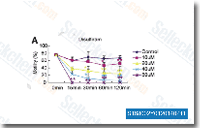
|
|
| S3124 | Dexamethasone Acetate | Dexamethasone (NSC 39471,Dexamethasone 21-acetate) is a potent synthetic member of the glucocorticoid class of steroid drugs, and an interleukin receptor modulator that has anti-inflammatory and immunosuppressant effects. |

|
|
| S7393 | Aloxistatin (E64d) | Aloxistatin (E64d) is an irreversible and membrane-permeable cysteine protease inhibitor with blood platelet aggregation inhibiting activity. The cysteine protease cathepsin L is required for SARS-CoV-2 viral entry, and aloxistatin treatment reduced cellular entry of SARS-CoV-2 pseudovirions by 92.3%. | ||
| S4028 | Dexamethasone Sodium Phosphate | Dexamethasone (Dexamethasone 21-phosphate disodium salt) is a potent synthetic member of the glucocorticoid class of steroid drugs, and an interleukin receptor modulator that has anti-inflammatory and immunosuppressant effects. |

|
|
| S1401 | Tenofovir | Tenofovir (GS-1278) blocks reverse transcriptase and hepatitis B virus infections. |
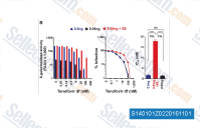
|
|
| S2823 | Tideglusib | Tideglusib is an irreversible, non ATP-competitive GSK-3β inhibitor with IC50 of 60 nM in a cell-free assay; fails to inhibit kinases with a Cys homologous to Cys-199 located in the active site. Phase 2. |
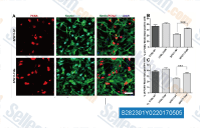
|
|
| S1835 | Azithromycin | Azithromycin is an antibiotic by inhibiting protein synthesis, used for the treatment of bacterial infections. | ||
| S1759 | Pitavastatin calcium | Pitavastatin calcium, a novel member of the medication class of statins, is a calcium salt formulation of pitavastatin which is a highly effective HMG-CoA reductase inhibitor. Pitavastatin Calcium attenuates AGEs-induced mitophagy via inhibition of ROS generation. Pitavastatin Calcium induces autophagy and apoptosis. |
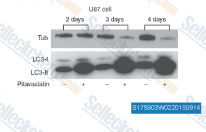
|
|
| S7975 | Favipiravir (T-705) | Favipiravir (T-705) is a potent and selective RNA-dependent RNA polymerase inhibitor, used to treat influenza virus infections. |
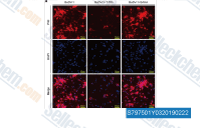
|
|
| S4282 | Nelfinavir Mesylate | Nelfinavir Mesylate is a potent HIV protease inhibitor with Ki of 2 nM. | ||
| S1183 | Danoprevir | Danoprevir is a peptidomimetic inhibitor of the NS3/4A protease of hepatitis C virus (HCV) with IC50 of 0.2-3.5 nM, inhibition effect for HCV genotypes 1A/1B/4/5/6 is ~10-fold higher than 2B/3A. Phase 2. |
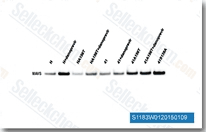
|
|
| S1706 | Lamivudine | Lamivudine is a potent nucleoside analog reverse transcriptase inhibitor, used for treatment of chronic HBV and HIV/AIDS. It works by blocking the HIV reverse transcriptase and hepatitis B virus polymerase. |
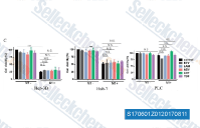
|
|
| S1351 | Ivermectin | Ivermectin is a glutamate-gated chloride channel (GluCls) activator, used as a broad-spectrum antiparasitic drug. Ivermectin (MK-933, IVM) is a specific positive allosteric effector of P2X4 and α7 nicotinic acetylcholine receptors (nAChRs). Ivermectin (MK-933) is a specific inhibitor of Impα/β1-mediated nuclear import and has potent antiviral activity towards both HIV-1 and dengue virus. Ivermectin induces autophagy through the AKT/mTOR signaling pathway and mitophagy. | ||
| S1289 | Carmofur | Carmofur (HCFU) is a highly potent acid ceramidase inhibitor, used in the treatment of breast and colorectal cancer. | ||
| S1386 | Nafamostat mesilate (FUT-175) | Nafamostat mesilate (FUT-175) is a synthetic serine protease inhibitor, used as an anticoagulant during hemodialysis. Nafamostat mesylate blocks activation of SARS-CoV-2 and is investigated as a new treatment option for COVID-19. Nafamostat Mesilate attenuates inflammation and apoptosis. |
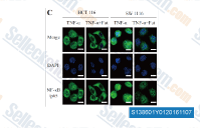
|
|
| S5754 | Baricitinib phosphate | Baricitinib phosphate (INCB-028050, LY-3009104) is a selective JAK1 and JAK2 inhibitor with IC50 of 5.9 nM and 5.7 nM, ~70 and ~10-fold selective versus JAK3 and Tyk2, no inhibition to c-Met and Chk2. Baricitinib is found to reduce or interrupt the passage of the virus into target cells and is used in the treatment research for COVID-19. | ||
| S2169 | Rosuvastatin calcium | Rosuvastatin calcium is a competitive inhibitor of HMG-CoA reductase with IC50 of 11 nM in a cell-free assay. |
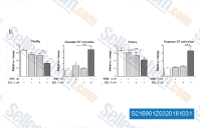
|
|
| S2874 | Camostat Mesilate | Camostat (FOY-305, FOY-S980) is a trypsin-like protease inhibitor, inhibits airway epithelial sodium channel (ENaC) function with IC50 of 50 nM, less potent to trpsin, prostasin and matriptase. | ||
| S7947 | PX-12 | PX-12 (DB05448, 1-methyl propyl 2-imidazolyl disulfide) is a potent thioredoxin-1 (Trx-1) inhibitor by irreversibly thioalkylation of Cys73 of Trx-1. Phase 2. | ||
| S3733 | Boceprevir | Boceprevir (EBP 520, SCH 503034) is an oral, direct acting hepatitis C virus (HCV) protease inhibitor with Ki value of 14 nM for NS3. It is used in combination with other antiviral agents in the treatment of chronic hepatitis C, genotype 1. | ||
| S3037 | Bepotastine Besilate | Bepotastine Besilate (TAU 284) is a non-sedating, selective antagonist of histamine 1 (H1) receptor with pIC50 of 5.7. | ||
| S1620 | Darunavir Ethanolate | Darunavir Ethanolate (TMC-114, UIC 94017) is a nonpeptidic HIV protease inhibitor, used to treat HIV infection. |
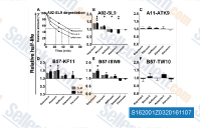
|
|
| S2926 | TDZD-8 | TDZD-8 (NP 01139) is a non-ATP competitive GSK-3β inhibitor with IC50 of 2 μM; minimal inhibitory effect observed on CDK1, casein kinase II, PKA and PKC. |
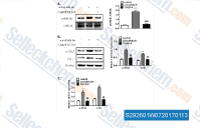
|
|
| S5250 | Darunavir | Darunavir (TMC114,DRV) is a nonpeptidic HIV protease inhibitor, used to treat HIV infection. | ||
| S8969 | Molnupiravir (EIDD-2801) | Molnupiravir (EIDD-2801, MK-4482) is an orally bioavailable prodrug of the ribonucleoside analog β-d-N4-hydroxycytidine (NHC; EIDD-1931) with broad-spectrum antiviral activity against SARS-CoV-2, MERS-CoV, SARS-CoV, and the causative agent of COVID-19. | ||
| S9866 | Nirmatrelvir (PF-07321332) | Nirmatrelvir (PF-07321332) is an reversible covalent inhibitor of SARS-CoV-2 main protease (Mpro, also referred to as 3CL protease) with an ki of 3.11 nM. PF-07321332 binds directly to the catalytic cysteine (Cys145) residue of the enzyme. |
||
| S7579 | Ledipasvir (GS5885) | Ledipasvir (GS5885) is a HCV NS5A polymerase inhibitor, used for the treatment of hepatitis C virus infection. |
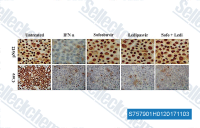
|
|
| S3079 | Atovaquone | Atovaquone (Atavaquone) is a medication used to treat or prevent for pneumocystis pneumonia, toxoplasmosis, malaria, and babesia. | ||
| S0833 | EIDD-1931 (NHC) | EIDD-1931 (NHC) is an active metabolite of EIDD-2801, a promising COVID-19 inhibitor. EIDD-1931 (NHC) has broad spectrum antiviral activity against SARS-CoV-2, MERS-CoV, SARS-CoV, and related zoonotic group 2b or 2c Bat-CoVs with average IC50 of 0.15 μM, as well as increased potency against a coronavirus bearing resistance mutations to the nucleoside analog inhibitor remdesivir. | ||
| S6676 | Ebselen | Ebselen (DR 3305, SPI-1005, PZ-51, CCG-39161) is a small-molecule capsid inhibitor of HIV-1 Replication with IC50 of 46.1 nM in TR-FRET assay. | ||
| S4646 | Ciclesonide | Ciclesonide (Alvesco, Omnaris, RPR251526, Zetonna) is a glucocorticoid used to treat obstructive airway diseases. | ||
| S9567 | Indinavir Sulfate | Indinavir sulfate (Crixivan, L-735524, MK-639) is a specific and potent inhibitor of HIV-1 protease and is widely used in the treatment of AIDS. | ||
| S7392 | Loxistatin Acid (E-64C) | Loxistatin Acid (E-64C, NSC 694279, EP 475), a derivative of E-64, is an irreversible and membrane-permeant cysteine protease inhibitor. The cysteine protease cathepsin L is required for SARS-CoV-2 viral entry. | ||
| S5911 | Bictegravir | Bictegravir (GS-9883) is a novel, potent, once-daily, unboosted inhibitor of HIV-1 integrase. | ||
| S9731 | PF-00835231 | PF-00835231 is a 3CLpro (Mpro) inhibitor that may targets SARS-CoV-2 protease 3CLpro as a potential new treatment for COVID-19. | ||
| S3724 | Velpatasvir | Velpatasvir (GS-5816,VEL) is a second-generation NS5A inhibitor that inhibits hepatitis C viral replication through acting on the crucial "membranous web" that facilitates RNA replication. | ||
| S7262 | Vidofludimus | Vidofludimus (SC12267, 4SC-101) is an orally active and potent dihydroorotate dehydrogenase (DHODH) inhibitor with IC50 of 134 nM for human DHODH. Vidofludimus calcium (IMU-838) is investigated as a potential treatment option for COVID-19. Phase 2. | ||
| S1691 | Praziquantel | Praziquantel is an anthelmintic effective against flatworms. |
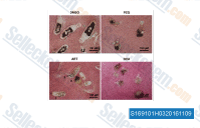
|
|
| S2071 | Prulifloxacin (NM441) | Prulifloxacin (NM441, AF 3013), the prodrug of ulifloxacin, is a broad-spectrum oral fluoroquinolone antibacterial agent. | ||
| S2079 | Moexipril HCl | Moexipril HCl (RS-10085) is a potent orally active nonsulfhydryl angiotensin converting enzyme (ACE) inhibitor, used for the treatment of hypertension and congestive heart failure. | ||
| S5940 | Bepotastine | Bepotastine is a non-sedating, selective antagonist of the histamine 1 (H1) receptor that is indicated in allergic rhinitis, urticaria, and pruritus associated with skin disease. | ||
| S8279 | (±)-Shikonin | (±)-Shikonin, a potent and specific Pyruvate kinase M2 (PKM2) inhibitor, is a major component of zicao (purple gromwell, the dried root of Lithospermum erythrorhizon), a Chinese herbal medicine with various biological activities. It is also an inhibitor of TMEM16A chloride channel activity using cell-based fluorescent-quenching assay. Shikonin exerts an anti-inflammatory effect by inhibiting tumor necrosis factor-α (TNF-α) and prevents activation of nuclear factor-κB (NF-κB) pathway via proteasome inhibition. | ||
| S9858 | Lufotrelvir (PF-07304814) | PF-07304814 is a phosphate prodrug of PF-00835231 that binds and inhibits SARS-CoV-2 3CLpro activity with a Ki of 174 nM. | ||
| S3511 | FOY251 | FOY251, an active metabolite of camostat mesilate, is an inhibitor of synthetic serine protease. FOY251 inhibits SARS-CoV-2 infection. | ||
| S0875 | XP-59 | XP-59 is a potent inhibitor of the SARS-CoV Mpro, with a Ki of 0.1 μM. | ||
| E1112 | GS-621763 | GS-621763, an orally bioavailable prodrug of GS-441524, shows a dose-dependent antiviral effect on SARS-CoV-2 reporter virus expressing nanoluciferase (SARS-CoV-2 nLUC) replication with an EC50 of 2.8 μM, also inhibits reporter SARS-CoV-2 expressing firefly luciferase (SARS-CoV-2 Fluc) replication with EC50 of 0.125 μM. | ||
| S3553 | Riamilovir | Riamilovir (Triazavirin) is a broad-spectrum antiviral drug candidate, which can be used for potential application against the Coronavirus 2019-nCoV. | ||
| E1111 | VV116 | VV116, a promising orally administered anti-SARS-CoV-2 nucleoside drug candidate, exerts functions by targeting the viral RNA-dependent RNA polymerase through its nucleoside triphosphate form with an IC50 of 0.67±0.24 μM. | ||
| E0052 | Merafloxacin | Merafloxacin (CI-934) is a fluoroquinolone antibacterial thats inhibit -1 frameshifting efficiency of SARS-CoV-2 and other betacoronaviruses. | ||
| E1131 | Ensitrelvir fumarate | S-217622 (Ensitrelvir fumarate) is the first orally active non-covalent, non-peptidic, SARS-CoV-2 3CL protease inhibitor with IC50 of 13 nM. | ||
| S9963 | paquinimod | Paquinimod (ABR 25757), a specific inhibitor of S100A8/A9, could rescue the pneumonia with substantial reduction of viral loads in SARS-CoV-2-infected mice. | ||
| E1174 | Coronastat(NK01-63) | Coronastat(NK01-63) is a potent inhibitor of the SARS-CoV-2 3CL protease, which is a critical drug target for small molecule COVID-19, given its likely druggability and essentiality in the viral maturation and replication cycle. | ||
| S2853 | Carfilzomib (PR-171) | Carfilzomib (PR-171) is an irreversible proteasome inhibitor with IC50 of <5 nM in ANBL-6 cells, displayed preferential in vitro inhibitory potency against the ChT-L activity in the β5 subunit, but little or no effect on the PGPH and T-L activities. Carfilzomib activates prosurvival autophagy and induces cell apoptosis. |

|
|
| S4157 | Chloroquine diphosphate | Chloroquine diphosphate is a 4-aminoquinoline anti-malarial and anti-rheumatoid agent, also acting as an ATM activator. Chloroquine is also an inhibitor of toll-like receptors (TLRs). |

|
|
| S6999 | Chloroquine | Chloroquine is an antimalarial drug and autophagy/lysosome inhibitor. Chloroquine also suppresses Toll-like receptor-9 (TLR9) protein expression. Chloroquine is highly effective agianst SARS-CoV-2 (COVID-19) infection with EC50 of 1.13 μM in Vero E6 cells. Chloroquine has anti-HIV-1 activity. | ||
| S4430 | Hydroxychloroquine (HCQ) Sulfate | Hydroxychloroquine (HCQ) Sulfate is an antimalarial agent used for the treatment of systemic lupus erythematosus, rheumatoid arthritis and other autoimmune, inflammatory and dermatologic conditions. Also acts as an inhibitor of autophagy and toll-like receptor (TLR) 7/9. |

|
|
| S1322 | Dexamethasone | Dexamethasone is a potent synthetic member of the glucocorticoid class of steroid drugs, and an interleukin receptor modulator that has anti-inflammatory and immunosuppressant effects. Dexamethasone induces autophagy and mitophagy. Dexamethasone is tested in hospitalized patients with COVID-19 and is found to have benefits for critically ill patients. |

|
|
| S8932 | Remdesivir (GS-5734) | Remdesivir (GS-5734), a monophosphoramidate prodrug of an adenosine analog, is an investigational broad-spectrum antiviral agent with in vitro activity against multiple RNA viruses, including Ebola and CoV. | ||
| S3035 | Daunorubicin HCl | Daunorubicin HCl inhibits both DNA and RNA synthesis and inhibits DNA synthesis with Ki of 0.02 μM in a cell-free assay. Daunorubicin is a topoisomerase II inhibitor that induces apoptosis.Daunorubicin (RP 13057) HCl can be used to induce animal models of Kidney Disease. |

|
|
| S2851 | Baricitinib (LY3009104) | Baricitinib is a selective JAK1 and JAK2 inhibitor with IC50 of 5.9 nM and 5.7 nM in cell-free assays, ~70 and ~10-fold selective versus JAK3 and Tyk2, no inhibition to c-Met and Chk2. Baricitinib is found to reduce or interrupt the passage of the virus into target cells and is used in the treatment research for COVID-19. Phase 3. |

|
|
| S2485 | Mitoxantrone 2HCl | Mitoxantrone 2HCl is a dihydrochloride salt of Mitoxantrone. Mitoxantrone is an inhibitor of type II topoisomerase and protein kinase C (PKC) with IC50 of 8.5 μM for PKC. Mitoxantrone inhibits cell proliferative growth of MCF-7/wt cells with IC50 of 0.42 μM. Mitoxantrone also induces apoptosis. |

|
|
| S1380 | Lopinavir (ABT-378) | Lopinavir (ABT-378) is a potent HIV protease inhibitor with Ki of 1.3 pM in a cell-free assay. |

|
|
| S1538 | Telaprevir | Telaprevir is an HCV NS3-4A serine protease inhibitor with IC50 of 0.35 μM. |

|
|
| S1185 | Ritonavir | Ritonavir is a Cytochrome P450 3A and Protease Inhibitor; Also inhibits Cytochrome P450 2D6, P-Glycoprotein and induces Cytochrome P450 2C19, Cytochrome P450 1A2, Cytochrome P450 2C9, Cytochrome P450 2B6 and UDP Glucuronosyltransferases. Ritonavir induces apoptosis. |

|
|
| S1680 | Disulfiram (Tetraethylthiuram disulfide) | Disulfiram is a specific inhibitor of aldehyde-dehydrogenase (ALDH) with IC50 of 0.15 μM and 1.45 μM for hALDH1 and hALDH2, respectively. Disulfiram is used for the treatment of chronic alcoholism by producing an acute sensitivity to alcohol. Disulfiram induces apoptosis. Disulfiram is also an inhibitor of pore formation by gasdermin D (GSDMD). |

|
|
| S3124 | Dexamethasone Acetate | Dexamethasone (NSC 39471,Dexamethasone 21-acetate) is a potent synthetic member of the glucocorticoid class of steroid drugs, and an interleukin receptor modulator that has anti-inflammatory and immunosuppressant effects. |

|
|
| S7393 | Aloxistatin (E64d) | Aloxistatin (E64d) is an irreversible and membrane-permeable cysteine protease inhibitor with blood platelet aggregation inhibiting activity. The cysteine protease cathepsin L is required for SARS-CoV-2 viral entry, and aloxistatin treatment reduced cellular entry of SARS-CoV-2 pseudovirions by 92.3%. | ||
| S4028 | Dexamethasone Sodium Phosphate | Dexamethasone (Dexamethasone 21-phosphate disodium salt) is a potent synthetic member of the glucocorticoid class of steroid drugs, and an interleukin receptor modulator that has anti-inflammatory and immunosuppressant effects. |

|
|
| S1401 | Tenofovir | Tenofovir (GS-1278) blocks reverse transcriptase and hepatitis B virus infections. |

|
|
| S2823 | Tideglusib | Tideglusib is an irreversible, non ATP-competitive GSK-3β inhibitor with IC50 of 60 nM in a cell-free assay; fails to inhibit kinases with a Cys homologous to Cys-199 located in the active site. Phase 2. |

|
|
| S1835 | Azithromycin | Azithromycin is an antibiotic by inhibiting protein synthesis, used for the treatment of bacterial infections. | ||
| S1759 | Pitavastatin calcium | Pitavastatin calcium, a novel member of the medication class of statins, is a calcium salt formulation of pitavastatin which is a highly effective HMG-CoA reductase inhibitor. Pitavastatin Calcium attenuates AGEs-induced mitophagy via inhibition of ROS generation. Pitavastatin Calcium induces autophagy and apoptosis. |

|
|
| S7975 | Favipiravir (T-705) | Favipiravir (T-705) is a potent and selective RNA-dependent RNA polymerase inhibitor, used to treat influenza virus infections. |

|
|
| S4282 | Nelfinavir Mesylate | Nelfinavir Mesylate is a potent HIV protease inhibitor with Ki of 2 nM. | ||
| S1183 | Danoprevir | Danoprevir is a peptidomimetic inhibitor of the NS3/4A protease of hepatitis C virus (HCV) with IC50 of 0.2-3.5 nM, inhibition effect for HCV genotypes 1A/1B/4/5/6 is ~10-fold higher than 2B/3A. Phase 2. |

|
|
| S1706 | Lamivudine | Lamivudine is a potent nucleoside analog reverse transcriptase inhibitor, used for treatment of chronic HBV and HIV/AIDS. It works by blocking the HIV reverse transcriptase and hepatitis B virus polymerase. |

|
|
| S1351 | Ivermectin | Ivermectin is a glutamate-gated chloride channel (GluCls) activator, used as a broad-spectrum antiparasitic drug. Ivermectin (MK-933, IVM) is a specific positive allosteric effector of P2X4 and α7 nicotinic acetylcholine receptors (nAChRs). Ivermectin (MK-933) is a specific inhibitor of Impα/β1-mediated nuclear import and has potent antiviral activity towards both HIV-1 and dengue virus. Ivermectin induces autophagy through the AKT/mTOR signaling pathway and mitophagy. | ||
| S1289 | Carmofur | Carmofur (HCFU) is a highly potent acid ceramidase inhibitor, used in the treatment of breast and colorectal cancer. | ||
| S1386 | Nafamostat mesilate (FUT-175) | Nafamostat mesilate (FUT-175) is a synthetic serine protease inhibitor, used as an anticoagulant during hemodialysis. Nafamostat mesylate blocks activation of SARS-CoV-2 and is investigated as a new treatment option for COVID-19. Nafamostat Mesilate attenuates inflammation and apoptosis. |

|
|
| S5754 | Baricitinib phosphate | Baricitinib phosphate (INCB-028050, LY-3009104) is a selective JAK1 and JAK2 inhibitor with IC50 of 5.9 nM and 5.7 nM, ~70 and ~10-fold selective versus JAK3 and Tyk2, no inhibition to c-Met and Chk2. Baricitinib is found to reduce or interrupt the passage of the virus into target cells and is used in the treatment research for COVID-19. | ||
| S2169 | Rosuvastatin calcium | Rosuvastatin calcium is a competitive inhibitor of HMG-CoA reductase with IC50 of 11 nM in a cell-free assay. |

|
|
| S2874 | Camostat Mesilate | Camostat (FOY-305, FOY-S980) is a trypsin-like protease inhibitor, inhibits airway epithelial sodium channel (ENaC) function with IC50 of 50 nM, less potent to trpsin, prostasin and matriptase. | ||
| S7947 | PX-12 | PX-12 (DB05448, 1-methyl propyl 2-imidazolyl disulfide) is a potent thioredoxin-1 (Trx-1) inhibitor by irreversibly thioalkylation of Cys73 of Trx-1. Phase 2. | ||
| S3733 | Boceprevir | Boceprevir (EBP 520, SCH 503034) is an oral, direct acting hepatitis C virus (HCV) protease inhibitor with Ki value of 14 nM for NS3. It is used in combination with other antiviral agents in the treatment of chronic hepatitis C, genotype 1. | ||
| S3037 | Bepotastine Besilate | Bepotastine Besilate (TAU 284) is a non-sedating, selective antagonist of histamine 1 (H1) receptor with pIC50 of 5.7. | ||
| S1620 | Darunavir Ethanolate | Darunavir Ethanolate (TMC-114, UIC 94017) is a nonpeptidic HIV protease inhibitor, used to treat HIV infection. |

|
|
| S2926 | TDZD-8 | TDZD-8 (NP 01139) is a non-ATP competitive GSK-3β inhibitor with IC50 of 2 μM; minimal inhibitory effect observed on CDK1, casein kinase II, PKA and PKC. |

|
|
| S5250 | Darunavir | Darunavir (TMC114,DRV) is a nonpeptidic HIV protease inhibitor, used to treat HIV infection. | ||
| S8969 | Molnupiravir (EIDD-2801) | Molnupiravir (EIDD-2801, MK-4482) is an orally bioavailable prodrug of the ribonucleoside analog β-d-N4-hydroxycytidine (NHC; EIDD-1931) with broad-spectrum antiviral activity against SARS-CoV-2, MERS-CoV, SARS-CoV, and the causative agent of COVID-19. | ||
| S9866 | Nirmatrelvir (PF-07321332) | Nirmatrelvir (PF-07321332) is an reversible covalent inhibitor of SARS-CoV-2 main protease (Mpro, also referred to as 3CL protease) with an ki of 3.11 nM. PF-07321332 binds directly to the catalytic cysteine (Cys145) residue of the enzyme. |
||
| S7579 | Ledipasvir (GS5885) | Ledipasvir (GS5885) is a HCV NS5A polymerase inhibitor, used for the treatment of hepatitis C virus infection. |

|
|
| S3079 | Atovaquone | Atovaquone (Atavaquone) is a medication used to treat or prevent for pneumocystis pneumonia, toxoplasmosis, malaria, and babesia. | ||
| S0833 | EIDD-1931 (NHC) | EIDD-1931 (NHC) is an active metabolite of EIDD-2801, a promising COVID-19 inhibitor. EIDD-1931 (NHC) has broad spectrum antiviral activity against SARS-CoV-2, MERS-CoV, SARS-CoV, and related zoonotic group 2b or 2c Bat-CoVs with average IC50 of 0.15 μM, as well as increased potency against a coronavirus bearing resistance mutations to the nucleoside analog inhibitor remdesivir. | ||
| S6676 | Ebselen | Ebselen (DR 3305, SPI-1005, PZ-51, CCG-39161) is a small-molecule capsid inhibitor of HIV-1 Replication with IC50 of 46.1 nM in TR-FRET assay. | ||
| S4646 | Ciclesonide | Ciclesonide (Alvesco, Omnaris, RPR251526, Zetonna) is a glucocorticoid used to treat obstructive airway diseases. | ||
| S9567 | Indinavir Sulfate | Indinavir sulfate (Crixivan, L-735524, MK-639) is a specific and potent inhibitor of HIV-1 protease and is widely used in the treatment of AIDS. | ||
| S7392 | Loxistatin Acid (E-64C) | Loxistatin Acid (E-64C, NSC 694279, EP 475), a derivative of E-64, is an irreversible and membrane-permeant cysteine protease inhibitor. The cysteine protease cathepsin L is required for SARS-CoV-2 viral entry. | ||
| S5911 | Bictegravir | Bictegravir (GS-9883) is a novel, potent, once-daily, unboosted inhibitor of HIV-1 integrase. | ||
| S9731 | PF-00835231 | PF-00835231 is a 3CLpro (Mpro) inhibitor that may targets SARS-CoV-2 protease 3CLpro as a potential new treatment for COVID-19. | ||
| S3724 | Velpatasvir | Velpatasvir (GS-5816,VEL) is a second-generation NS5A inhibitor that inhibits hepatitis C viral replication through acting on the crucial "membranous web" that facilitates RNA replication. | ||
| S7262 | Vidofludimus | Vidofludimus (SC12267, 4SC-101) is an orally active and potent dihydroorotate dehydrogenase (DHODH) inhibitor with IC50 of 134 nM for human DHODH. Vidofludimus calcium (IMU-838) is investigated as a potential treatment option for COVID-19. Phase 2. | ||
| S1691 | Praziquantel | Praziquantel is an anthelmintic effective against flatworms. |

|
|
| S2071 | Prulifloxacin (NM441) | Prulifloxacin (NM441, AF 3013), the prodrug of ulifloxacin, is a broad-spectrum oral fluoroquinolone antibacterial agent. | ||
| S2079 | Moexipril HCl | Moexipril HCl (RS-10085) is a potent orally active nonsulfhydryl angiotensin converting enzyme (ACE) inhibitor, used for the treatment of hypertension and congestive heart failure. | ||
| S5940 | Bepotastine | Bepotastine is a non-sedating, selective antagonist of the histamine 1 (H1) receptor that is indicated in allergic rhinitis, urticaria, and pruritus associated with skin disease. | ||
| S8279 | (±)-Shikonin | (±)-Shikonin, a potent and specific Pyruvate kinase M2 (PKM2) inhibitor, is a major component of zicao (purple gromwell, the dried root of Lithospermum erythrorhizon), a Chinese herbal medicine with various biological activities. It is also an inhibitor of TMEM16A chloride channel activity using cell-based fluorescent-quenching assay. Shikonin exerts an anti-inflammatory effect by inhibiting tumor necrosis factor-α (TNF-α) and prevents activation of nuclear factor-κB (NF-κB) pathway via proteasome inhibition. | ||
| S9858 | Lufotrelvir (PF-07304814) | PF-07304814 is a phosphate prodrug of PF-00835231 that binds and inhibits SARS-CoV-2 3CLpro activity with a Ki of 174 nM. | ||
| S3511 | FOY251 | FOY251, an active metabolite of camostat mesilate, is an inhibitor of synthetic serine protease. FOY251 inhibits SARS-CoV-2 infection. | ||
| S0875 | XP-59 | XP-59 is a potent inhibitor of the SARS-CoV Mpro, with a Ki of 0.1 μM. | ||
| E1112 | GS-621763 | GS-621763, an orally bioavailable prodrug of GS-441524, shows a dose-dependent antiviral effect on SARS-CoV-2 reporter virus expressing nanoluciferase (SARS-CoV-2 nLUC) replication with an EC50 of 2.8 μM, also inhibits reporter SARS-CoV-2 expressing firefly luciferase (SARS-CoV-2 Fluc) replication with EC50 of 0.125 μM. | ||
| E1111 | VV116 | VV116, a promising orally administered anti-SARS-CoV-2 nucleoside drug candidate, exerts functions by targeting the viral RNA-dependent RNA polymerase through its nucleoside triphosphate form with an IC50 of 0.67±0.24 μM. | ||
| E0052 | Merafloxacin | Merafloxacin (CI-934) is a fluoroquinolone antibacterial thats inhibit -1 frameshifting efficiency of SARS-CoV-2 and other betacoronaviruses. | ||
| E1131 | Ensitrelvir fumarate | S-217622 (Ensitrelvir fumarate) is the first orally active non-covalent, non-peptidic, SARS-CoV-2 3CL protease inhibitor with IC50 of 13 nM. | ||
| S9963 | paquinimod | Paquinimod (ABR 25757), a specific inhibitor of S100A8/A9, could rescue the pneumonia with substantial reduction of viral loads in SARS-CoV-2-infected mice. | ||
| E1174 | Coronastat(NK01-63) | Coronastat(NK01-63) is a potent inhibitor of the SARS-CoV-2 3CL protease, which is a critical drug target for small molecule COVID-19, given its likely druggability and essentiality in the viral maturation and replication cycle. |
